7.1E: Exercises
- Last updated
- Nov 19, 2020
- Save as PDF
- Page ID
- 26193
( \newcommand{\kernel}{\mathrm{null}\,}\)
Exercise 7.1E.1−2
In the following exercises, use the midpoint rule with m=4 and n=2 to estimate the volume of the solid bounded by the surface z=f(x,y), the vertical planes x=1, x=2, y=1, and y=2, and the horizontal plane x=0.
1. f(x,y)=4x+2y+8xy
2. f(x,y)=16x2+y2
- Answer
-
1) 27units3
2) 37.6units3
Exercise 7.1E.3−4
In the following exercises, estimate the volume of the solid under the surface z=f(x,y) and above the rectangular region R by using a Riemann sum with m=n=2 and the sample points to be the lower left corners of the subrectangles of the partition.
3. f(x,y)=sin(x)−cos(y), R=[0,π]×[0,π]
4. f(x,y)=cos(x)+cos(y), R=[0,π]×[0,π2]
- Answer
-
3) 0units3
4) (6+3√28)π2units3
Exercise 7.1E.5−8
5. Use the midpoint rule with m=n=2 to estimate ∬Rf(x,y)dA, where the values of the function f on R=[8,10]×[9,11] are given in the following table.
| y | |||||
|---|---|---|---|---|---|
| x | 9 | 9.5 | 10 | 10.5 | 11 |
| 8 | 9.8 | 5 | 6.7 | 5 | 5.6 |
| 8.5 | 9.4 | 4.5 | 8 | 5.4 | 3.4 |
| 9 | 8.7 | 4.6 | 6 | 5.5 | 3.4 |
| 9.5 | 6.7 | 6 | 4.5 | 5.4 | 6.7 |
| 10 | 6.8 | 6.4 | 5.5 | 5.7 | 6.8 |
- Answer
-
5) 21.3units3.
6) 35.42units3.
6. The values of the function f on the rectangle R=[0,2]×[7,9] are given in the following table. Estimate the double integral ∬Rf(x,y)dA by using a Riemann sum with m=n=2. Select the sample points to be the upper right corners of the subsquares of R.
| y0=7 | y1=8 | y2=9 | |
|---|---|---|---|
| x0=0 | 10.22 | 10.21 | 9.85 |
| x1=1 | 6.73 | 9.75 | 9.63 |
| x2=2 | 5.62 | 7.83 | 8.21 |
7. The depth of a children’s 4-ft by 4-ft swimming pool, measured at 1-ft intervals, is given in the following table.
- Estimate the volume of water in the swimming pool by using a Riemann sum with m=n=2. Select the sample points using the midpoint rule on R=[0,4]×[0,4].
- Find the average depth of the swimming pool.
y x 0 1 2 3 4 0 1 1.5 2 2.5 3 1 1 1.5 2 2.5 3 2 1 1.5 1.5 2.5 3 3 1 1 1.5 2 2.5 4 1 1 1 1.5 2
- Answer
-
1. 28 ft3
2. 1.75 ft.
8. The depth of a 3-ft by 3-ft hole in the ground, measured at 1-ft intervals, is given in the following table.
- Estimate the volume of the hole by using a Riemann sum with m=n=3 and the sample points to be the upper left corners of the subsquares of R.
- Find the average depth of the hole.
y x 0 1 2 3 0 6 6.5 6.4 6 1 6.5 7 7.5 6.5 2 6.5 6.7 6.5 6 3 6 6.5 5 5.6
Exercise 7.1E.9−10
9. The level curves f(X,Y)=K of the function f are given in the following graph, where k is a constant.
- Apply the midpoint rule with m=n=2 to estimate the double integral ∬Rf(x,y)dA, where R=[0.2,1]×[0,0.8].
- Estimate the average value of the function f on R.
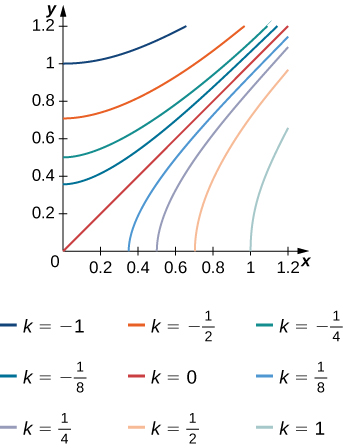
- Answer
-
a. 0.112 b. fave≃0.175; here f(0.4,0.2)≃0.1, f(0.2,0.6)≃−0.2, f(0.8,0.2)≃0.6, and f(0.8,0.6)≃0.2.
10. The level curves f(x,y)=k of the function f are given in the following graph, where k is a constant.
- Apply the midpoint rule with m=n=2 to estimate the double integral ∬Rf(x,y)dA, where R=[0.1,0.5]×[0.1,0.5].
- Estimate the average value of the function f on R.
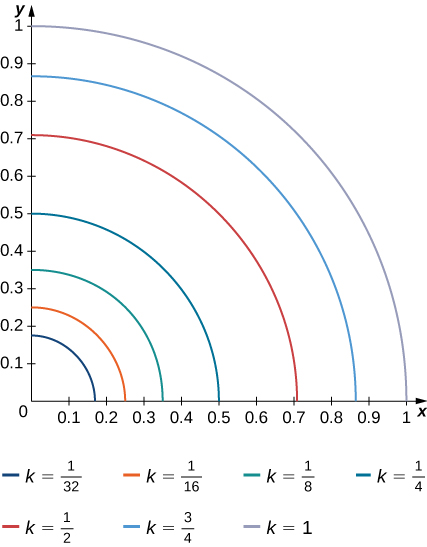
Exercise 7.1E.11−12
11. The solid lying under the surface z=√4−y2 and above the rectangular region R=[0,2]×[0,2] is illustrated in the following graph. Evaluate the double integral ∬Rf(x,y), where f(x,y)=√4−y2 by finding the volume of the corresponding solid.
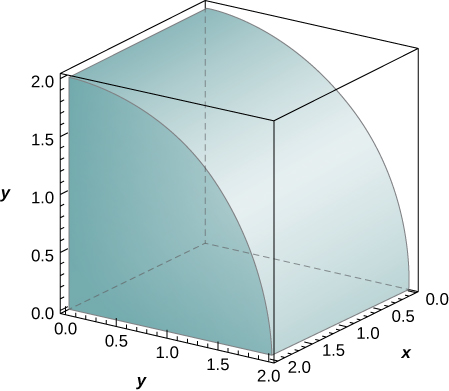
- Answer
-
11) 2πunits3
12) 48units3
12. The solid lying under the plane z=y+4 and above the rectangular region R=[0,2]×[0,4] is illustrated in the following graph. Evaluate the double integral ∬Rf(x,y)dA, where f(x,y)=y+4, by finding the volume of the corresponding solid.
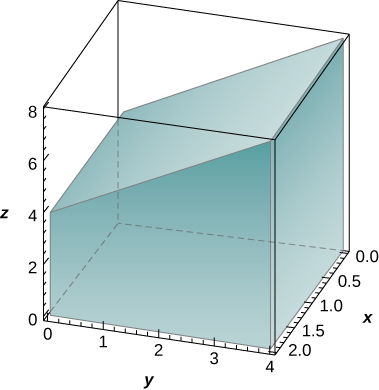
Exercise 7.1E.13−20
In the following exercises, calculate the integrals by interchanging the order of integration.
13. ∫1−1(∫2−2(2x+3y+5)dx) dy
- Answer
-
40
14. ∫20(∫10(x+2ey+3)dx) dy
15. ∫271(∫21(3√x+3√y)dy) dx
- Answer
-
812+393√2.
16. ∫161(∫81(4√x+23√y)dy) dx
17. ∫ln 3ln 2(∫10ex+ydy) dx
- Answer
-
e−1.
18. ∫20(∫103x+ydy) dx
19. ∫61(∫92√yy2dy) dx
- Answer
-
15−10√29.
20. ∫91(∫24√xy2dy)dx
Exercise 7.1E.21−34
In the following exercises, evaluate the iterated integrals by choosing the order of integration.
21. ∫π0∫π/20sin(2x)cos(3y)dx dy
- Answer
-
0.
22. ∫π/8π/12∫π/3π/4[cot(x)+tan(2y)]dx dy
23. ∫e1∫e1[1xsin(ln x)+1ycos(ln y)]dx dy
- Answer
-
(e−1)(1+sin(1)−cos(1))
24. ∫e1∫e1sin(ln x)cos(ln y)xydx dy
25. ∫21∫21(ln yx+x2y+1)dy dx
- Answer
-
34ln(53)+2b ln22−ln 2
26. ∫e1∫21x2ln(x)dy dx
27. ∫√31∫21y arctan(1x)dy dx
- Answer
-
18[(2√3−3)π+6 ln 2].
28. ∫10∫1/20(arcsin x+arcsin y)dy dx
29. ∫10∫20xex+4ydy dx
- Answer
-
14e4(e4−1).
30. ∫21∫10xex−ydy dx
31. ∫e1∫e1(ln y√y+ln x√x)dy dx
- Answer
-
4(e−1)(2−√e).
32. ∫e1∫e1(x ln y√y+y ln x√x)dy dx
33. ∫10∫21(xx2+y2)dy dx
- Answer
-
−π4+ln(54)−12ln 2+arctan 2.
34. ∫10∫21yx+y2dy dx
Exercise 7.1E.35−38
In the following exercises, find the average value of the function over the given rectangles.
35. f(x,y)=−x+2y, R=[0,1]×[0,1]
- Answer
-
12.
36. f(x,y)=x4+2y3, R=[1,2]×[2,3]
37. f(x,y)=sinh x+sinh y, R=[0,1]×[0,2]
- Answer
-
12(2 cosh 1+cosh 2−3).
38. f(x,y)=arctan(xy), R=[0,1]×[0,1]
Exercise 7.1E.39
39. Let f and g be two continuous functions such that 0≤m1≤f(x)≤M1 for any x∈[a,b] and 0≤m2≤g(y)≤M2 for anyy∈[c,d]. Show that the following inequality is true:
m1m2(b−a)(c−d)≤∫ba∫dcf(x)g(y)dydx≤M1M2(b−a)(c−d).
Exercise 7.1E.40−43
In the following exercises, use property v. of double integrals and the answer from the preceding exercise to show that the following inequalities are true.
40. 1e2≤∬Re−x2−y2 dA≤1, where R=[0,1]×[0,1]
41. π2144≤∬Rsin(x) cos(y)dA≤π248, where R=[π6,π3]×[π6,π3]
42. 0≤∬Re−y cos(x) dA≤π2, where R=[0,π2]×[0,π2]
43. 0≤∬R(ln x)(ln y)dA≤(e−1)2, where R=[1,e]×[1,e]
Exercise 7.1E.44
44. Let f and g be two continuous functions such that 0≤m1≤f(x)≤M1 for any x∈[a,b] and 0≤m2≤g(y)≤M2 for any y∈[c,d]. Show that the following inequality is true:
(m1+m2)(b−a)(c−d)≤∫ba∫dc|f(x)+g(y)| dy dx≤(M1+M2)(b−a)(c−d).
Exercise 7.1E.45−48
In the following exercises, use property v. of double integrals and the answer from the preceding exercise to show that the following inequalities are true.
45. 2e≤∬R(e−x2+e−y2)dA≤2, where R=[0,1]×[0,1]
46. π236∬R(sin(x)+cos(y))dA≤π2√336, where R=[π6,π3]×[π6,π3]
47. π2e−π/2≤∬R(cos(x)+e−y)dA≤π, where R=[0,π2]×[0,π2]
48. 1e≤∬R(e−y−ln x)dA≤2, where R=[0,1]×[0,1]
Exercise 7.1E.49−50
In the following exercises, the function f is given in terms of double integrals.
- Determine the explicit form of the function f.
- Find the volume of the solid under the surface z=f(x,y) and above the region R.
- Find the average value of the function f on R.
- Use a computer algebra system (CAS) to plot z=f(x,y) and z=fave in the same system of coordinates.
49. [T] f(x,y)=∫y0∫x0(xs+yt)ds dt, where (x,y)∈R=[0,1]×[0,1]
- Answer
-
a. f(x,y)=12xy(x2+y2); b. V=∫10∫10f(x,y)dx dy=18; c. fave=18;
d.
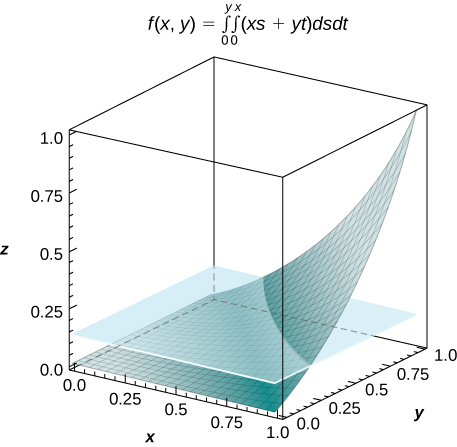
50. [T] f(x,y)=∫x0∫y0[cos(s)+cos(t)]dt ds, where (x,y)∈R=[0,3]×[0,3]
Exercise 7.1E.51−52
51. Show that if f and g are continuous on [a,b] and [c,d], respectively, then
∫ba∫dc|f(x)+g(y)|dy dx=(d−c)∫baf(x)dx
+∫ba∫dcg(y)dy dx=(b−a)∫dcg(y)dy+∫dc∫baf(x)dx dy.
52. Show that ∫ba∫dcyf(x)+xg(y)dy dx=12(d2−c2)(∫baf(x)dx)+12(b2−a2)(∫dcg(y)dy).
Exercise 7.1E.53−54
53. [T] Consider the function f(x,y)=e−x2−y2, where (x,y)∈R=[−1,1]×[−1,1].
- Use the midpoint rule with m=n=2,4,...,10 to estimate the double integral I=∬Re−x2−y2dA. Round your answers to the nearest hundredths.
- For m=n=2, find the average value of f over the region R. Round your answer to the nearest hundredths.
- Use a CAS to graph in the same coordinate system the solid whose volume is given by ∬Re−x2−y2dA and the plane z=fave.
- Answer
-
a. For m=n=2, I=4e−0.5≈2.43 b. fave=e−0.5≃0.61;
c.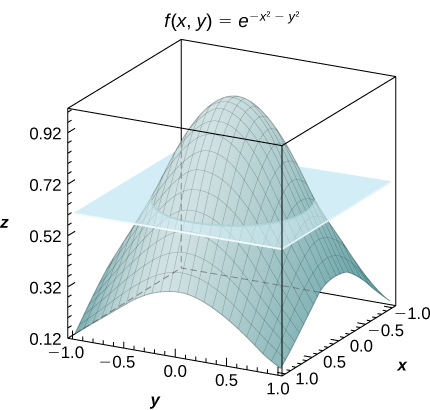
54. [T] Consider the function f(x,y)=sin(x2) cos(y2), where (x,y∈R=[−1,1]×[−1,1].
- Use the midpoint rule with m=n=2,4,...,10 to estimate the double integral I=∬Rsin(x2) cos(y2) dA. Round your answers to the nearest hundredths.
- For m=n=2, find the average value of f over the region R. Round your answer to the nearest hundredths.
- Use a CAS to graph in the same coordinate system the solid whose volume is given by ∬Rsin(x2) cos(y2) dA and the plane z=fave.
Exercise 7.1E.55−56
In the following exercises, the functions fnfn are given, where n≥1 is a natural number.
- Find the volume of the solids Sn under the surfaces z=fn(x,y) and above the region R.
- Determine the limit of the volumes of the solids Sn as n increases without bound.
55. f(x,y)=xn+yn+xy, (x,y)∈R=[0,1]×[0,1]
- Answer
-
a. 2n+1+14 b. 14
56. f(x,y)=1xn+1yn, (x,y)∈R=[1,2]×[1,2]
Exercise 7.1E.57
57. Show that the average value of a function f on a rectangular region R=[a,b]×[c,d] is fave≈1mn∑mi=1∑nj=1f(x∗ij,y∗ij),where (x∗ij,y∗ij) are the sample points of the partition of R, where 1≤i≤m and 1≤j≤n.
Exercise 7.1E.58
58. Use the midpoint rule with m=n to show that the average value of a function f on a rectangular region R=[a,b]×[c,d] is approximated by
fave≈1n2n∑i,j=1f(12(xi=1+xi), 12(yj=1+yj)).
Exercise 7.1E.59
59. An isotherm map is a chart connecting points having the same temperature at a given time for a given period of time. Use the preceding exercise and apply the midpoint rule with m=n=2 to find the average temperature over the region given in the following figure.
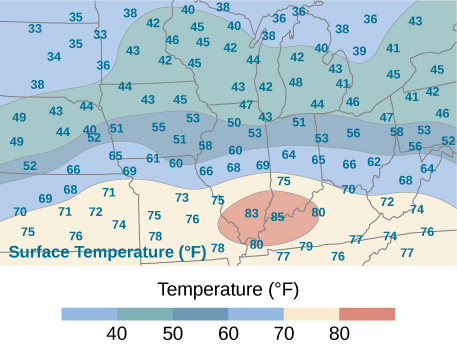
- Answer
-
56.5∘ F; here f(x∗1,y∗1)=71, f(x∗2,y∗1)=72, f(x∗2,y∗1)=40, f(x∗2,y∗2)=43, where x∗i and y∗j are the midpoints of the subintervals of the partitions of [a,b] and [c,d], respectively


